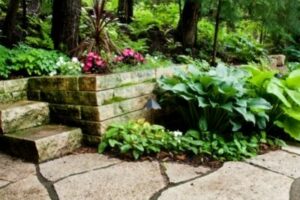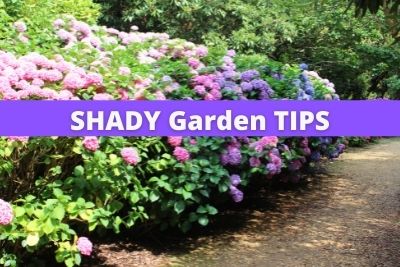It is a beautiful landscape, a perfect spot for a garden, you say. If only this piece of land got more sunlight!, you say. Don’t give up on the idea. You can, in fact, garden with shade. It only requires a different thought process — and a different type of plant — to add vibrant colors to your yard.
Even without the sun shining directly on that beautiful landscape, the possibilities for a shade garden are endless. The easiest way to start is to design key features around what you have and what you don’t.
Trees in the yard are a natural border. Look for areas around the roots and in places where you can’t grow grass. That’s prime real estate for plants that don’t need sunlight. Can you use rocks or other earthen formations? Maybe accent those natural areas with a man-made walkway or water hole.
 You can overcome things like rocky terrain or slopes with creative design decisions. Consider using planting beds — starting small and working your way to bigger beds as the need arises. Perhaps a few frost-proof pots will come in handy. You get the idea.
You can overcome things like rocky terrain or slopes with creative design decisions. Consider using planting beds — starting small and working your way to bigger beds as the need arises. Perhaps a few frost-proof pots will come in handy. You get the idea.
Of course, the central feature is what you choose to plant in the garden.
Choosing your plants and shrubs
The right mix of annuals and perennials, together with ground cover as needed will turn that “perfect spot” garden from fantasy to reality.
Envision Hosta plants and ferns and bleeding hearts in that space. There are numerous perennials to choose from that are perfectly suited for total shade and need very little maintenance after they’ve been planted.
Ask your local independent landscape expert to show you plants with varying textures and colors, and how they might fit together with other varieties.
Master gardener Anita Tilley of Williamson County, Tennessee, took us on a tour of her shade garden. The structural piece is a Redbud tree, which attracts bees when an abundance of rosy pink flowers bloom in the spring.
Anita then planted Annabelle Hydrangeas — “some people refer to these as ‘snowball hydrangeas,’” she notes — that show off stunning pure white flowers.
“Underneath the hydrangeas, you can see the Helleborus — the common name is Lenten rose,” Anita says, as she walks around this section of her garden. “I’m going to let this area sort of naturalize with the Lenten rose, a beautiful plant for honeybees because…it provides an early pollen source for honeybees, so it’s really good nutritional value for them.”
Any plants that do double-duty like this are an especially good choice.
And try for more muted colors to give the garden a comfortable feel in the shade, then dot the landscape with a few vibrant hues that are eye-catching and exciting.
Think about planting perennials that spread on their own and grow into a large section, without you needing to do any additional work to make the garden look fuller and more robust.
Consult an independent landscaper to help you determine what works best to make your garden flourish.
Benjamin Marsh, who owns and operates Marsh Brothers Lawns & Landscaping, a family landscaping business in Winston-Salem, N.C., uses his background in chemistry and expertise in landscape design to feature the right plants and flowers in the right place in your garden.
“We are constantly experimenting with different plants and different environments,” Benjamin says. “I rarely give up on plants. If they don’t work in one place, I’ll pull it, bring it back home, nurse it back to life, and try it again somewhere else. I love plants.”
Ground cover plants
A versatile item for a shade garden is the ground cover plant because of its many purposes. You may need ground cover to highlight a plant with a new shape or different texture from the rest of the garden. Or you may need to hide thin grass and bare spots. Or to control weeds or discourage soil erosion.
Flowering thyme, spotted deadnettle and creeping myrtle are good options.
If other parts of your yard get direct sunlight — defined as at least six hours a day — you can give your garden an expanded, cohesive look by adding full sun perennial beds.
[Yard bathed in sunlight? Click here to read tips on growing a sunny garden.]
Whether structures or tree canopies or sloping terrain block the sun, it is possible to turn your shady yard into a tranquil and colorful garden that you can enjoy throughout the year.

